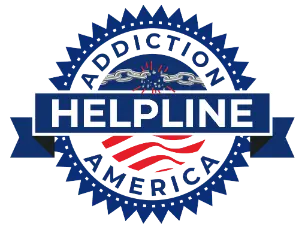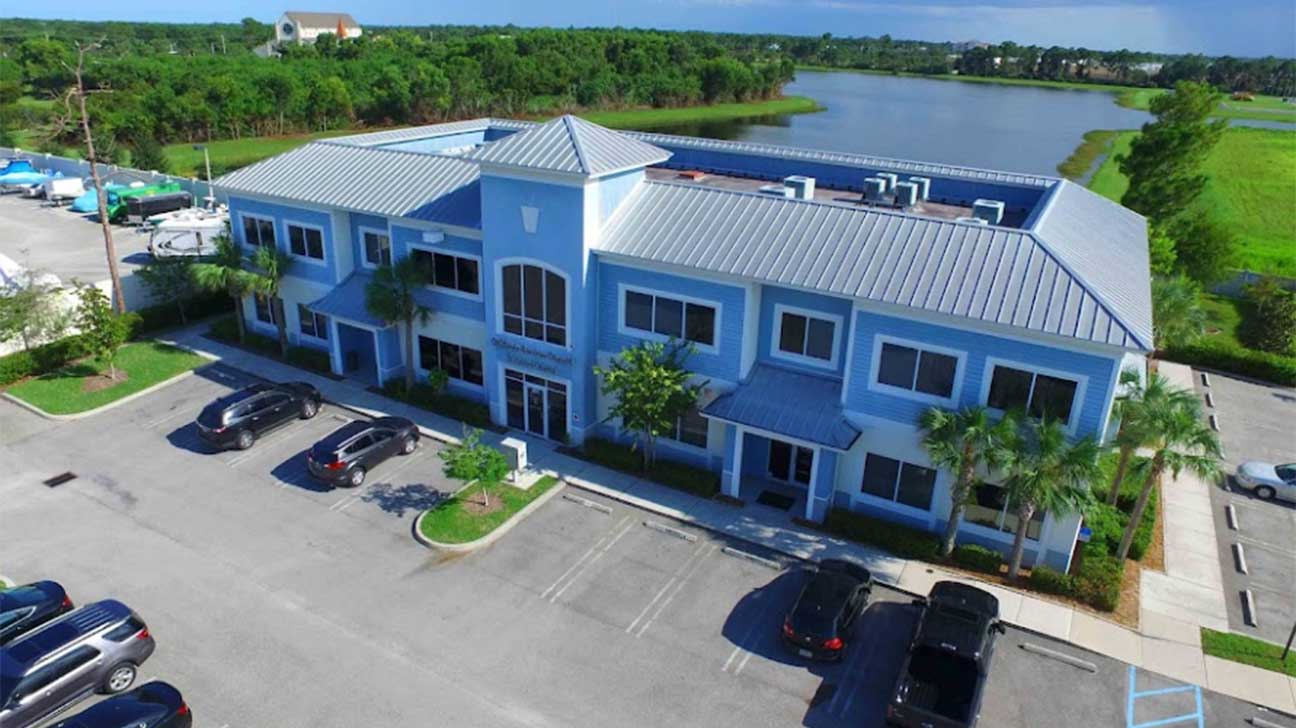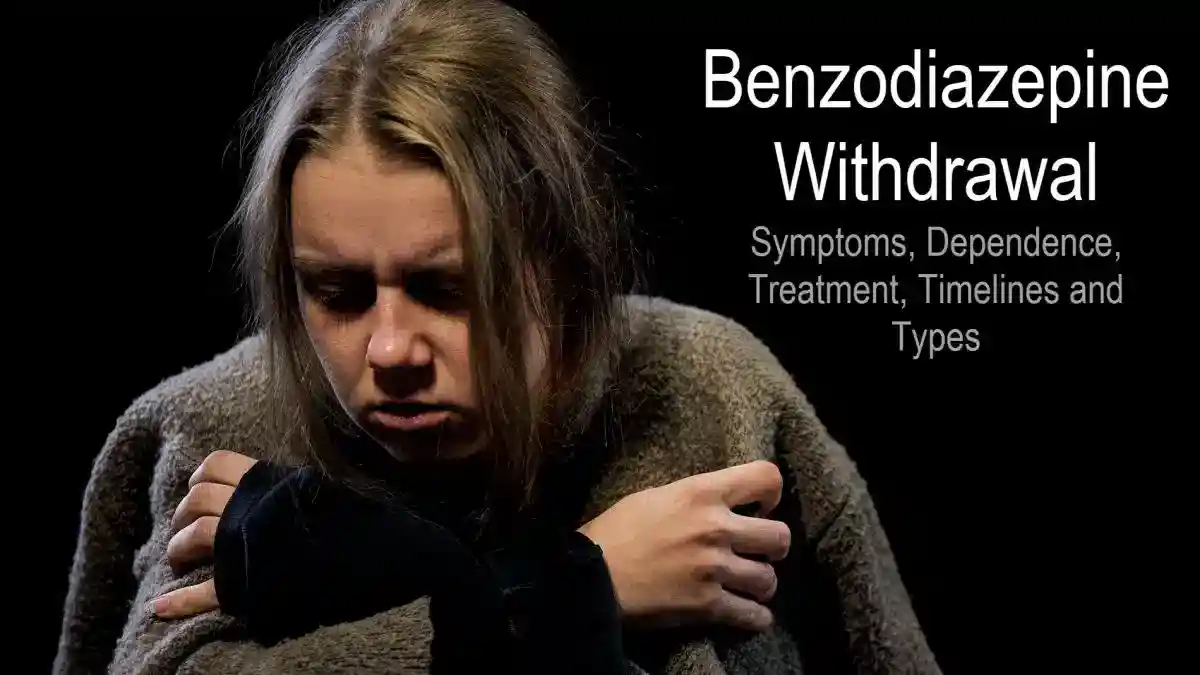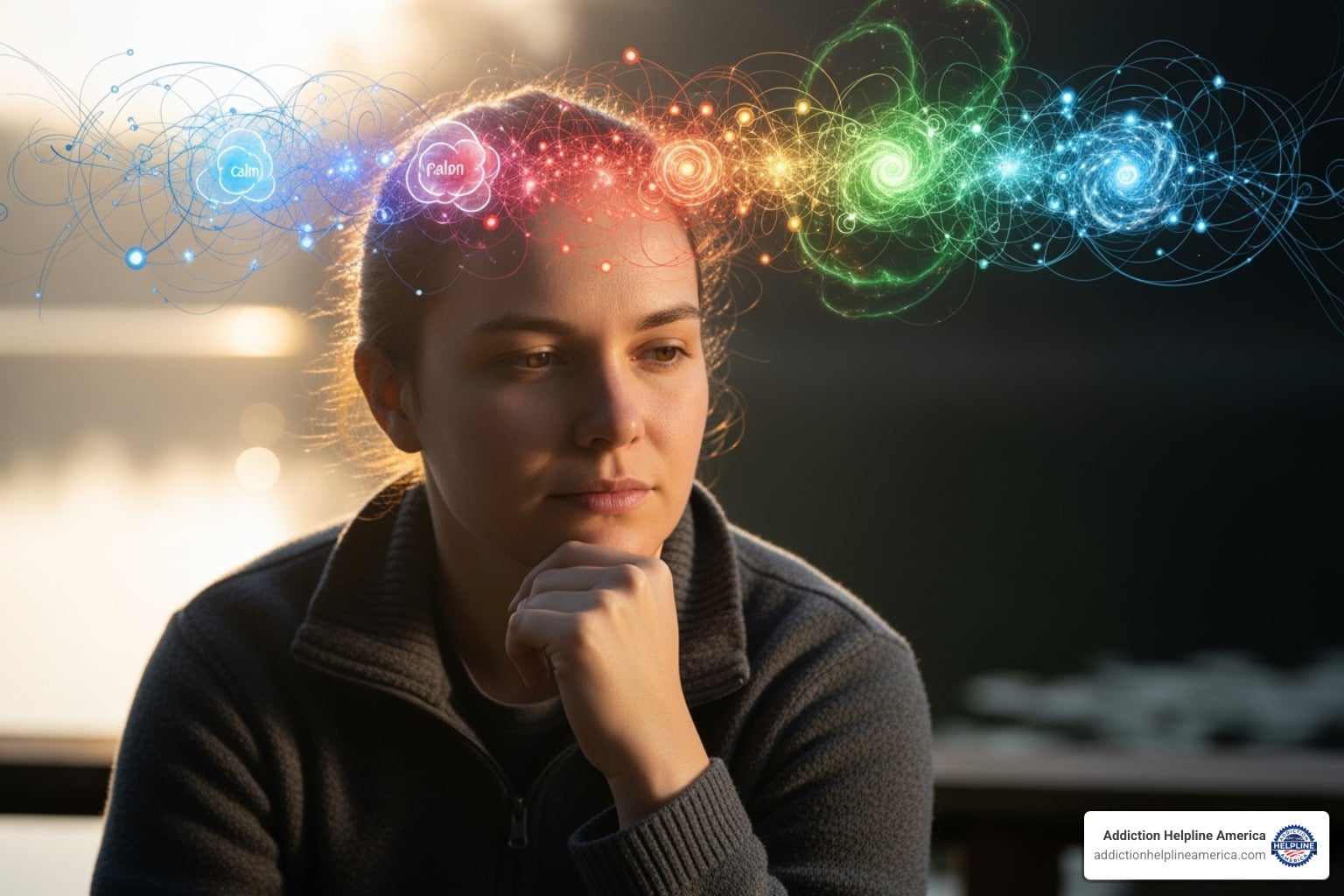
Understanding How Your Mind and Actions Connect
Cognitive behavioral therapy is a structured, evidence-based form of psychotherapy that helps people identify and change negative thought patterns and behaviors that contribute to emotional distress and mental health challenges.
Key aspects of cognitive behavioral therapy:
- Talk therapy approach – Work with a trained therapist to explore thoughts and behaviors
- Goal-oriented treatment – Focus on specific, measurable outcomes
- Structured sessions – Follow a clear framework with homework and skill practice
- Short-term commitment – Typically 5-20 sessions to see significant improvement
- Practical skills – Learn tools you can use independently after therapy ends
- Present-focused – Address current problems rather than dwelling on past events
CBT works by helping you understand the powerful connection between your thoughts, feelings, and behaviors. When you change how you think about situations, your emotions and actions naturally follow suit. This creates positive cycles that replace the negative patterns keeping you stuck.
The approach is particularly effective for addiction recovery because it teaches concrete coping strategies and helps identify the thinking patterns that often lead to substance use.
At Addiction Helpline America, our experienced team regularly connects individuals with qualified CBT therapists who specialize in addiction and mental health treatment. We understand how cognitive behavioral therapy can be a cornerstone of lasting recovery and emotional wellness.
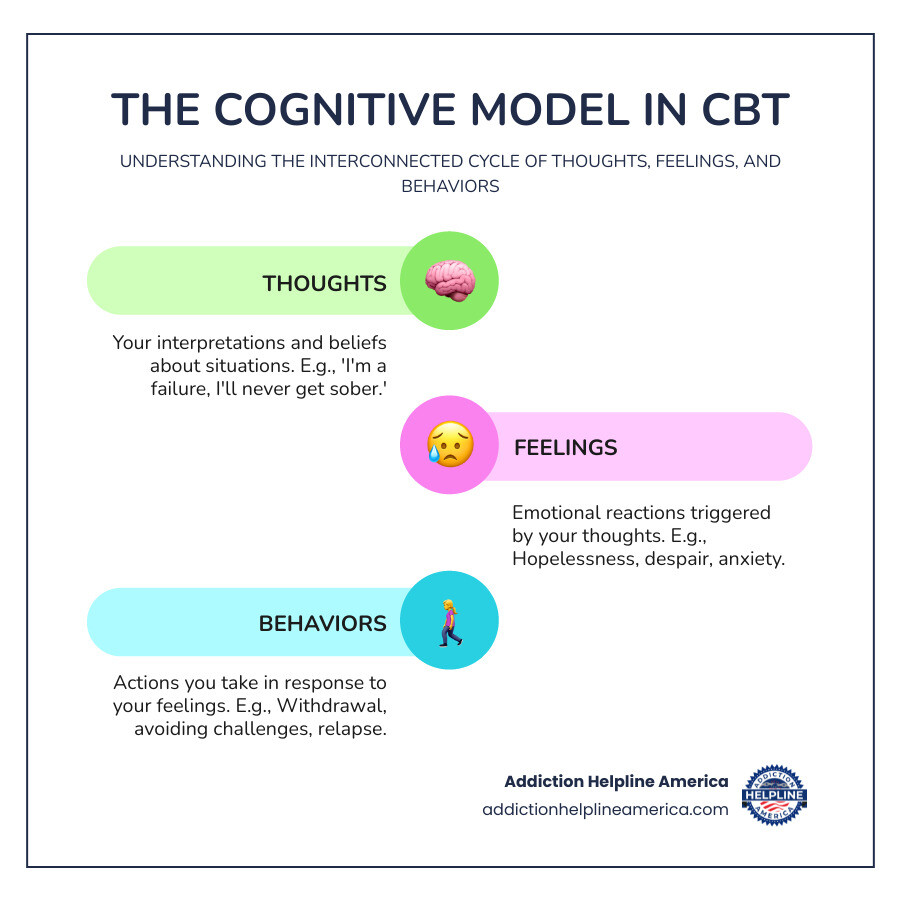
The Core Principles and Process of Cognitive Behavioral Therapy

Your thoughts can be like a narrator in your head. Sometimes this narrator is encouraging, but other times it’s a harsh critic that makes you feel terrible and act in unhelpful ways.
Cognitive behavioral therapy is built on understanding this connection between what we think, how we feel, and what we do. This is the Cognitive Model. When someone with an addiction thinks, “I’m weak and will never stay clean,” that thought creates feelings of shame and hopelessness, making substance use more likely as a way to escape the pain.
The good news is that thoughts influence feelings, and feelings influence actions. By learning to change automatic negative thoughts, you can shift your emotions and behaviors. CBT teaches practical skills to break these negative cycles.
The approach is both problem-focused and goal-directed. Instead of spending years on your childhood, CBT asks: “What specific problems are bothering you now, and what concrete steps can we take to solve them?”
Cognitive behavioral therapy has roots in the work of Aaron T. Beck and Albert Ellis. In the 1960s, Beck identified “automatic thoughts” in his depressed patients, while Ellis developed similar ideas about how irrational beliefs create emotional problems. Their work transformed therapy from just talking about problems to actively teaching skills to solve them, giving birth to the structured, practical approach used today.
CBT also involves homework. This isn’t about math problems but practical exercises like journaling about thoughts and feelings, practicing new coping skills, or conducting behavioral experiments to test anxious thoughts. For example, if you fear judgment at a support group, your homework might be to attend one meeting and observe what actually happens. Often, these experiments show our fears are worse than reality.
How cognitive behavioral therapy helps you take control
Cognitive behavioral therapy puts you back in charge of your life, starting with functional analysis. This process involves identifying triggers—people, places, or situations—that set off difficult thoughts, feelings, or behaviors. Once patterns are understood, you can build better responses.
Skill building is where the magic happens. CBT teaches problem-solving techniques to tackle challenges directly. You’ll learn cognitive restructuring, which means examining your thoughts like a detective. When an inner critic says, “You’re a failure,” you’ll learn to ask: “Is that really true? What’s the evidence?”
Behavioral activation is helpful when depression or addiction has made you stop enjoyable activities. We’ll help you schedule small, manageable activities to lift your mood and rebuild a sense of accomplishment.
CBT also works on different levels of cognition. It starts with surface-level automatic thoughts but also digs deeper into core beliefs or schemas—fundamental beliefs about yourself, others, and the world (e.g., “I’m not worthy of love”). By examining and challenging these beliefs, we can create lasting change.
The collaborative nature of CBT
Cognitive behavioral therapy is a team effort. You and your therapist build a strong therapeutic alliance, working together as partners.
Your active participation is essential. This team approach means setting an agenda together each session and providing regular feedback on what’s working. This shared decision-making ensures therapy is relevant to your life. You’re the expert on your experience, and your therapist is the expert on CBT techniques. Together, you’ll apply these strategies to your unique situation.
At Addiction Helpline America, we understand how powerful this collaborative approach is. We’ll help you find qualified CBT therapists who specialize in addiction and know how to create this supportive partnership that leads to real, lasting change.
What to Expect From Your CBT Journey
Taking the first step toward cognitive behavioral therapy can feel both exciting and nerve-wracking. You might be wondering what actually happens in those therapy sessions, or how long this whole process will take. Let’s walk through what you can expect so you feel prepared and confident going in.
Your first session is all about getting to know each other. Think of it as a friendly conversation where your therapist learns about you, your challenges, and what you’re hoping to achieve. This initial meeting is called an assessment, but don’t let that formal name worry you. Your therapist will ask about the problems you’re facing, your background, and what brought you to therapy today.
This is also when you’ll start building rapport with your therapist. That comfortable, trusting feeling doesn’t happen overnight, but a good therapist will help you feel heard and understood from day one. You’ll discuss your goals together and begin creating a treatment plan that makes sense for your specific situation. Your therapist will also explain exactly how cognitive behavioral therapy works and answer any questions you might have.
Once you get into the rhythm of regular sessions, you’ll notice that CBT has a clear structure. Many people find this predictable format actually quite comforting. Each session typically starts with agenda setting – you and your therapist decide together what you want to focus on that day.
You’ll spend time reviewing any homework from the previous week. This isn’t like school homework – it’s practical stuff like keeping a thought journal or trying out a new coping skill. Your therapist will want to hear how it went, what worked, what didn’t, and how you felt about the experience.
The middle part of each session is where you’ll be learning new skills or practicing ones you’ve already started working on. This might involve challenging negative thoughts, role-playing difficult conversations, or working through problem-solving exercises. Before you leave, you’ll wrap up by summarizing what you covered and planning new homework to practice between sessions.
Most people attend weekly sessions that last about 50 minutes to an hour. The beauty of cognitive behavioral therapy is that it’s designed to be relatively short-term compared to other types of therapy. While everyone’s journey is different, most people see significant improvement within 5 to 20 sessions.
The exact number depends on what you’re working on and how quickly you pick up the skills. Some people dealing with specific phobias might see changes in just a few sessions, while others working through complex trauma or long-standing depression might need more time. Your therapist will check in with you regularly about your progress and adjust the timeline as needed.
The ultimate goal is to help you become your own therapist. By the time you finish treatment, you’ll have a solid toolkit of skills you can use independently whenever life throws you a curveball. At Addiction Helpline America, we understand how important it is to find a CBT therapist who’s the right fit for your specific needs, and we’re here to help connect you with qualified professionals in your area.
The Wide-Ranging Effectiveness of CBT

Cognitive behavioral therapy is a versatile tool for mental health, with proven strategies for many different situations, from depression and anxiety to trauma and PTSD.
For depression, CBT helps you identify and challenge automatic negative thoughts that lead to hopelessness. Combined with behavioral activation—gradually reintroducing meaningful activities—many people find their mood lifts significantly.
Anxiety disorders (including generalized anxiety, panic attacks, and phobias) respond well to CBT, which teaches you to face fears gradually while challenging the anxious thoughts that fuel them.
CBT also helps with:
- Trauma and PTSD, using trauma-focused techniques to process difficult memories safely.
- Obsessive-Compulsive Disorder, using exposure and response prevention to break the cycle of obsessions and compulsions.
- Eating disorders, by addressing distorted thoughts about food, weight, and body image.
- Bipolar disorder, often used with medication to manage mood swings and develop coping strategies.
- Substance use disorders, a cornerstone of recovery that teaches relapse prevention and helps manage cravings.
Cognitive behavioral therapy is also helpful for physical issues. For chronic pain, it changes how you relate to pain, helping you stay active. For insomnia, CBT-I helps reset sleep patterns naturally. It also helps manage symptoms of fibromyalgia and Irritable Bowel Syndrome.
The principles adapt across age groups. Evidence for CBT in youth shows it’s effective for children and adolescents dealing with anxiety, depression, and behavioral challenges.
Comparing cognitive behavioral therapy to other treatments
How does cognitive behavioral therapy compare to other treatments? Unlike psychodynamic therapy, which often explores the past, CBT focuses on the here and now. Its goal-oriented approach means you learn practical skills you can use immediately.
CBT is also set apart by its evidence-based nature. It has been rigorously tested in scientific studies, which is one reason why CBT is a gold standard of psychotherapy.
For conditions like depression and anxiety, studies show CBT can be as effective as antidepressant medication. When used together, people often see better results and lower relapse rates.
This is particularly important for addiction recovery. While medication can manage withdrawal or cravings, CBT provides the psychological tools to handle triggers, stress, and daily challenges that could lead to relapse, promoting long-term prevention.
At Addiction Helpline America, we’ve seen how powerful cognitive behavioral therapy can be in a comprehensive treatment plan. The skills you learn become tools you carry with you long after therapy ends, making lasting recovery possible.
Making CBT Work for You
When you’re considering cognitive behavioral therapy, it’s helpful to understand both what makes it so effective and what it asks of you. Like any meaningful change in life, getting the most from CBT requires knowing what you’re getting into.
The beauty of cognitive behavioral therapy lies in its practical, evidence-based approach. You’re not just talking about problems – you’re learning actual skills that become part of your mental toolkit for life. These are practical skills you can use long after therapy ends, whether you’re dealing with cravings, anxiety, or negative thought spirals.
Most people appreciate that CBT is typically a short-term commitment. While you might work with a therapist for several months, you’re not looking at years of sessions. The approach is effective for many issues, from depression and anxiety to addiction and chronic pain. Plus, if you have transportation challenges or prefer privacy, CBT can be done online with great success.
But let’s be honest about what CBT asks of you. It requires commitment – not just showing up to sessions, but doing the work between them. Those homework assignments and thought journals aren’t busy work; they’re where the real change happens. Sometimes the process can be uncomfortable. When you start challenging thoughts you’ve believed for years or facing situations you’ve been avoiding, it can feel scary or emotionally draining.
And despite what you might hope, CBT is not a quick fix. While it’s shorter than many therapies, meaningful change still takes time and consistent effort. Think of it like physical therapy for your mind – the exercises work, but only if you do them regularly.
Finding a qualified therapist makes all the difference in your CBT experience. Look for credentials like licensed psychologists, clinical social workers, or licensed professional counselors who have specific training in CBT. Many therapists have specializations too – some focus on addiction, others on trauma or anxiety disorders.
At Addiction Helpline America, we understand how important it is to find the right therapeutic match. Our team regularly connects people with qualified CBT therapists who specialize in addiction and mental health. We know which providers have the experience and approach that work best for different situations.
Integrating CBT into your overall treatment plan often works beautifully. Many people combine it with medication for improved results, especially for conditions like depression or anxiety. You might also find CBT principles in self-help books that reinforce what you’re learning in therapy. Adding mindfulness practices can help too – they teach you to observe your thoughts and feelings without immediately reacting to them, which perfectly complements CBT’s approach to changing thought patterns.
The goal isn’t just to get through therapy, but to build a comprehensive approach to your well-being that supports you for years to come.
Frequently Asked Questions about CBT
When people first learn about cognitive behavioral therapy, they naturally have questions. Understanding what makes CBT unique can help you feel more confident about taking this important step in your recovery journey.
What is the main difference between CBT and other “talk therapies”?
The biggest difference with cognitive behavioral therapy is its structure and focus. While some therapies explore past experiences, CBT is more like using a GPS to reach a specific goal. It focuses on the here and now—what’s happening in your life today and how to change it.
Every CBT session has a clear agenda. You’ll get helpful homework assignments and learn specific skills you can use right away. While other therapies may be more open-ended, CBT emphasizes learning practical tools and applying them to your daily life. This goal-oriented approach is valuable for addiction recovery, providing concrete strategies to handle cravings and triggers.
Does CBT work for everyone?
While cognitive behavioral therapy has a high success rate, it’s not a magic cure-all. Success largely depends on your participation and commitment to practicing the skills. The therapeutic alliance—the trust and collaboration between you and your therapist—is also crucial.
If CBT isn’t the perfect fit, it doesn’t mean therapy has failed. It may just mean a different approach is needed. Open communication with your therapist is key, as they can modify the approach or explore other evidence-based treatments that might be a better match.
Can CBT be delivered online or through an app?
Yes, cognitive behavioral therapy translates beautifully to digital formats, making it more accessible. Internet-based CBT (iCBT) is proven to be as effective as in-person therapy for many conditions like anxiety and depression. This is great for people in rural areas, with transportation challenges, or who prefer the privacy of therapy from home.
Online options include:
- Live video sessions that work like traditional therapy.
- Guided iCBT programs with structured online modules and therapist support.
- Self-guided apps for practicing skills like mood tracking and thought challenging.
While apps are good supplements, we recommend guided programs or live sessions for more complex issues. The personalized feedback and human connection are invaluable for lasting change.
At Addiction Helpline America, we can help you find both in-person and online CBT options that fit your needs. The most important thing is to get started.
Conclusion
Cognitive behavioral therapy is more than a treatment—it’s a powerful tool for change. CBT is empowering, teaching you practical skills for your mental toolkit. Unlike approaches that foster dependency, CBT is designed to make you your own therapist.
What makes cognitive behavioral therapy so remarkable is its solid foundation in research. Backed by decades of scientific studies, it offers concrete, evidence-based strategies for addiction, anxiety, depression, and more. CBT puts you in control by teaching you to recognize patterns, challenge unhelpful thinking, and choose how to respond.
For those dealing with addiction, cognitive behavioral therapy can be life-changing. It provides the tools to understand cravings, handle triggers, and build a sober, fulfilling life. The skills you learn become a permanent part of your recovery.
At Addiction Helpline America, we’ve seen how CBT transforms lives. We are committed to connecting you with qualified CBT therapists who understand addiction and mental health. Our team provides free, confidential guidance to help you steer the process of finding the right treatment.
Taking the first step can be hard, but you don’t have to do it alone. We’re here to listen and connect you with professionals in our extensive network. Whether you need in-person or online therapy, we’ll help you find a CBT program that fits your life.
Find personalized mental health and addiction support and find how cognitive behavioral therapy can help you build the life you deserve. Your journey toward healing and lasting change can start today.
Our helpline is 100%
free & confidential
If you or someone you care about is struggling with drug or alcohol addiction, we can help you explore your recovery options. Don’t face this challenge alone—seek support from us.
Programs
Resources
Will my insurance
cover addiction
treatment?
We're ready to help
Find the best
drug or alcohol treatment
center
Are you or a loved one struggling with addiction? Call today to speak to a treatment expert.
